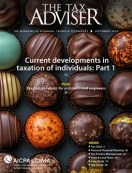- column
- PERSONAL FINANCIAL PLANNING
529 plans and education funding
Related
Government withdraws defense of retirement fiduciary rule
IRS outlines details for Trump accounts
How a CPA and wealth adviser partnership can guide families through transition
Editor: Theodore J. Sarenski, CPA/PFS
Funding the higher education of a child or grandchild can be one of the biggest financial accomplishments in someone’s life. Helping clients do so thoughtfully and with a plan will ensure that goal is not only attainable but also in line with their expectations. A great way to begin saving for college is to use a qualified tuition program under Sec. 529, more commonly referred to as a 529 plan.
Features and benefits of a 529 plan
A 529 plan is a tax-advantaged plan designed to encourage saving for future education expenses. Individual states sponsor 529 plans, although there are no restrictions against an individual’s opening an account in any given state.
Tax advantages to saving for college in a 529 plan — rather than a regular savings or brokerage account — include that earnings grow on a tax-deferred and potentially tax-free basis. That means account owners will not owe taxes on the account’s dividends, interest, capital gains, and other appreciation as long as the funds are used for qualified higher education expenses. Qualified higher education expenses include tuition, fees, books, supplies, and room and board (Sec. 529(e)(3); see also Toolson, “The Unique Benefits of 529 College Savings Plans,” 54-5 The Tax Adviser 30 (May 2023)).
Contributions to a 529 plan are not tax-deductible at the federal level; however, many states offer tax incentives, such as deductions or credits, for contributions to their specific 529 plans. In most cases, taxpayers must contribute to their home state’s 529 plan to qualify for a state income tax benefit. For example, an account owner or beneficiary who files a New York state resident return can claim a state income tax deduction of up to $5,000 for contributions to or withdrawals from a New York 529 plan ($10,000 if married filing jointly). If they are in the 6.85% state income tax bracket and make the full $5,000 contribution, it could be a tax savings of $342.50. However, if the same taxpayer contributed to another state’s 529 plan, they would not qualify for the New York state income tax deduction.
A 529 plan allows an individual to open an account on behalf of a designated beneficiary, most often a family member such as a child or grandchild. The account owner retains control over the funds and can make investment decisions within the plan’s options. They can also change the beneficiary or take back the funds for nonqualified purposes, although taxes and penalties may apply to nonqualified withdrawals.
Another benefit to 529 plans is that there are no annual contribution limits, unlike Sec. 401(k) plans and individual retirement accounts (IRAs). However, each state limits the total amount with which an account can be funded, which in 2023 is typically between $235,000 and $550,000. Families with considerable wealth have the option to fully fund a 529 account upfront, allowing the balance to take advantage of tax-free growth for the longest time possible.
For families concerned about estate tax, opening a 529 plan offers both gift and estate tax benefits. Contributions are considered completed gifts to the beneficiary. This allows contributions to reduce the donor’s taxable estate, but any amounts over the annual gift tax exclusion, which is $17,000 in 2023, would also reduce the donor’s lifetime applicable exclusion amount, which is $12.92 million for 2023. However, a special provision allows the gift giver to super-fund a 529 account up to five times the annual gift tax exclusion amount upfront and then spread it over five years.
For example, in 2023, a grandparent could contribute $85,000 (5 × $17,000) to their grandchild’s 529 account, and none of that amount would reduce their lifetime applicable exclusion amount, as long as they made the proper election on a timely filed gift tax return. However, if the contributor dies during the five-year period, the portion for the remainder of the period is included in the contributor’s estate. If both grandparents are alive, each grandparent could gift $85,000 to the same beneficiary for a total of $170,000. A couple could move considerable wealth from their estate if they had multiple family members whose educations they would like to fund through 529 plans.
How to choose the best 529 plan
Which type of plan?
529 plans come in two flavors, a savings plan and a prepaid tuition plan. Here are the pros, cons, and differences between how they operate and the expenses they cover:
529 savings plan: A 529 savings plan is an investment account that allows individuals to save money for future education expenses. The funds in the account are generally invested in such assets as mutual funds or exchange-traded funds. To the extent a 529 savings plan involves investing in financial markets, the account value will fluctuate based on the performance of the underlying investments.
Some level of investment risk, therefore, is involved, which can be considered a drawback for someone with little risk appetite or who has little to no knowledge of financial markets. However, many plans offer a range of investment options, including target-date funds and fixed-interest-rate investments, allowing them to choose a strategy that aligns with their investment acumen and risk tolerance.
A benefit of the 529 savings plan is that it offers more flexibility in how the funds can be used, compared with a 529 prepaid tuition plan. Funds in a savings plan can be used for a wide range of qualified higher education expenses, including tuition, fees, room and board, books, supplies, and certain computer equipment (Sec. 529(e)(3)). Distributions can be used at eligible colleges, universities, and vocational schools in the United States and are not limited to a specific state.
529 prepaid tuition plan: A 529 prepaid tuition plan allows individuals to prepay future tuition expenses at eligible colleges and universities. They purchase credits or units at today’s prices, which can be redeemed when the beneficiary attends a participating institution. The plan’s value is tied to tuition inflation rates. A 529 prepaid tuition plan is generally considered to have less investment risk than a savings plan, which can be considered a benefit to those who feel less comfortable investing in financial markets.
A 529 prepaid tuition plan is less flexible than a 529 savings plan and primarily only covers tuition and mandatory fees at participating colleges and universities. In some cases, it may also cover room and board expenses, but this varies by plan. Flexibility is also limited because the plan’s coverage is limited to the institutions specified in the plan. For instance, a Florida 529 prepaid tuition plan allows individuals to purchase credits toward Florida community colleges and state universities. As long as the beneficiary uses the credits to attend one of these instate designated colleges or universities, there is no need to worry about a price fluctuation from the purchase date until the beneficiary attends school. However, if the beneficiary chooses a nonparticipating institution or decides not to attend college, the plan may have restrictions or limitations on refunds.
In which state?
Once a decision is made on a 529 savings plan versus a 529 prepaid tuition plan, the owner will need to decide which state’s 529 plan they want to participate in. If they prefer a 529 prepaid tuition plan, it is most common to choose the plan of their home state, since the price they are locking in per unit or credit will be linked to the same state’s colleges and universities. However, a 529 prepaid tuition plan is now available only in a handful of states. Of 22 states that formerly offered them, only nine still did as of 2022 (see Flynn, “Your Guide to 529 Prepaid Tuition Plans,” Saving for College (Oct. 10, 2022), and Christensen, “The Last States with Prepaid Tuition Plans,” Investopedia (updated April 27, 2023)).
If clients decide on a 529 savings plan, they have more options, and they should consider more factors such as tax benefits (such as the previously mentioned potential state income tax deductions or credits), investment options, and fees and expenses. By researching each state’s 529 plan offerings and comparing them side by side, clients can make an informed decision about which one best meets their needs. Websites such as Saving for College offer unbiased analysis and tools to compare plans to help make the best decision for specific situations.
What if 529 funds are left over or the beneficiary does not attend college?
If funds remain in a 529 plan after the beneficiary has completed their education, or if they receive scholarships or other forms of financial aid, there are a few options for using the remaining funds.
Change the beneficiary: The 529 plan’s beneficiary can be changed to a “member of the family” (as defined by Sec. 529(e)(2)) of the original beneficiary. This can include siblings, parents, grandparents, aunts, uncles, a spouse, or even first cousins. Changing the beneficiary can ensure that the funds continue to be used for educational purposes without incurring any penalties or taxes. It is important to note that the change does need to be made immediately. If other family members (who may not even be born yet) might need educational funding in the future, the owner can maintain the 529 plan and designate them as the beneficiary when the time comes. This can be a way to continue the cycle of education savings within a family.
Hold the funds for future education expenses for the same beneficiary: The funds can be kept in the 529 plan and allowed to grow tax-free for future educational needs. This can be beneficial if the beneficiary pursues further education, such as graduate school or professional certifications, where the funds can be used. There is no time limit for using the funds in a 529 plan, so they can remain invested until needed.
Withdraw the funds for nonqualified expenses: If the account owner or beneficiary decides to withdraw the funds for nonqualified expenses, such as for personal use or expenses unrelated to education, the earnings portion of the withdrawal will be subject to federal income taxes and a 10% penalty. However, the principal contributions made to the 529 plan can be withdrawn tax-free since they were made with after-tax dollars.
Roll to a Roth IRA: The SECURE 2.0 Act, passed by Congress in 2022 as part of the Consolidated Appropriations Act, 2023, P.L. 117-328, creates a new provision under which, starting in 2024, 529 account holders will be able to transfer up to a lifetime limit of $35,000 to a Roth IRA for a beneficiary, both tax- and penalty-free. This provision requires the 529 plan’s beneficiary to have been the beneficiary for at least 15 years. Transfers to the Roth IRA are subject to annual contribution (but not the adjusted gross income) limits for Roth IRAs.
Use the funds for elementary and secondary education expenses: The law known as the Tax Cuts and Jobs Act, P.L. 115-97, enacted in 2017, expanded the definition of qualified education expenses to include up to $10,000 per year per student for tuition expenses at an elementary or secondary public, private, or religious school (Sec. 529(c)(7)).
Note that, while the federal government allows this provision, not all states have changed their tax laws to conform with the federal changes (or conformed automatically). Some states may still offer state tax benefits only for higher education expenses. Therefore, it is important to check whether a state’s rules and regulations regarding 529 plans allow tax benefits for primary and secondary education expenses.
Meeting family educational goals
Education planning is not a one-size-fits-all approach. Understanding and using tax-advantaged 529 accounts is one way to help families achieve their education goals for generations to come.
Contributors
Alexandra Demosthenes, CPA/PFS, CFP, is director of financial planning and a senior wealth adviser with Investment Advisory Professionals LLC in Boca Raton, Fla. Theodore J. Sarenski, CPA/PFS, is a wealth manager at SageView Advisory Group in Syracuse, N.Y. Sarenski also is a past chair of the AICPA Advanced Personal Financial Planning Conference, a past chair of the AICPA Personal Financial Planning Executive Committee, and a former member of the Tax Literacy Commission. For more information about this article, contact thetaxadviser@aicpa.org.
AICPA & CIMA RESOURCES
Publication
Riskin, Guide to Education Planning (2nd ed.) (PFP Section members)
Podcast
“Education Planning for the Next Decade: Practical Success Strategies” (Oct. 3, 2022) (PFP/PFS members)














